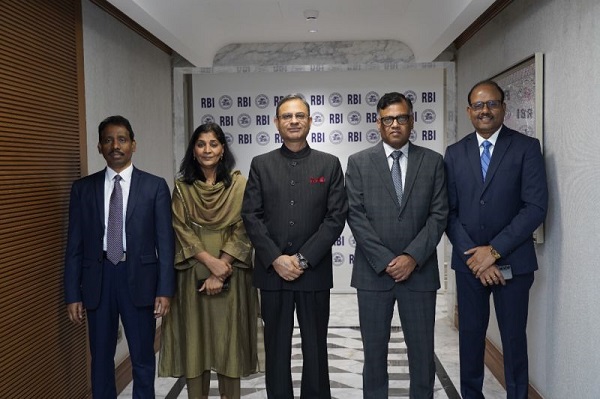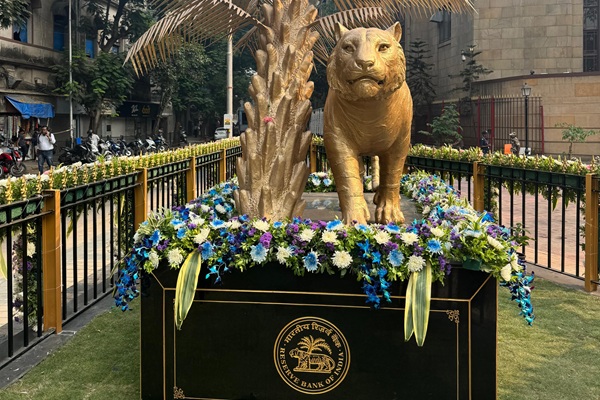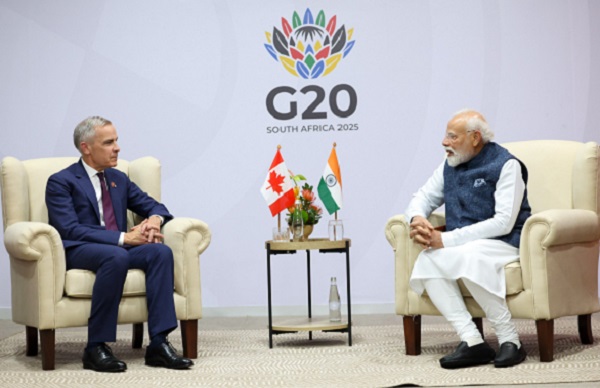.png)
Dollar Needs A Hedge As Global Reset Underway, Says ICICI Bank's Prasanna
The dollar is no longer sacrosanct, says B. Prasanna, who also sees 50 bps rate cuts, stable rupee, and mid-cap opportunities ahead.

June 5, 2025 at 8:26 AM IST
In a conversation rich with context and foresight, Prasanna Balachander, Group Head – Treasury at ICICI Bank and one of India’s most seasoned market voices, offers a comprehensive assessment of global macro shifts and their local repercussions.
Speaking to market veteran Manoj Rane for BasisPoint Insight, Prasanna dissects the global dollar realignment, Indian rate trajectory, capital flows, and market resilience with the precision of a trader and the perspective of a policymaker.
The centrepiece of his argument is a compelling view that the US dollar is no longer the unquestioned safe haven it once was. A confluence of erratic policy signals—from trade tariffs and fiscal profligacy to the Fed’s constrained monetary manoeuvring—has triggered a fundamental rethink among global asset allocators. “For the first time,” Prasanna observes, “the dollar itself needs a hedge.”
This structural rethink, he argues, will manifest in a gradual depreciation of the dollar, with ripple effects across global currencies, including the Indian rupee. And while India’s own external metrics are sound: narrow current account deficit, strong services exports, and muted oil prices, the Reserve Bank of India is unlikely to let the rupee appreciate sharply. His call: a near-term range of 84.50–86.00 on dollar/rupee.
On the domestic front, Prasanna expects the RBI to cut policy rates by 25 basis points in June and another 25 basis points in August, citing well-contained inflation, durable liquidity surplus, and a manageable current account deficit.
Liquidity management, he notes, has shifted into a deliberate surplus mode, with interbank rates expected to stay below the repo rate. His forecast sees the 10-year government bond yield falling to 6.15–6.30% by the end of June.
Equity markets, in his view, are entering a stock-picker’s phase, with mid-caps and thematic plays offering better traction than headline indices. Despite global volatility, India is holding up better than most, aided by decoupling from US markets and tempered reactions to tariff shocks.
The interview spans themes from growth surprises and bond curve dynamics to capital flow patterns and valuation cycles—making it essential reading for anyone navigating the uncertain contours of the 2025–2026 macro-financial landscape.
Please click here for the full video of the interview.
Read the edited excerpts of the interview.
Q: Is the US dollar structurally weak now? What does that mean for global currencies and Japan?
A: Something transformational is underway in the global US dollar market. Asset allocators are beginning to think very differently, and that shift is rooted in the broader context of economic growth and deepening policy uncertainty. We are seeing flip-flops in tariffs, foreign policy, fiscal policy, and monetary policy—all colliding in ways that heighten the uncertainty premium across asset classes. That, in turn, affects how each asset class behaves.
Tariffs, in particular, have triggered a sort of stagflation—higher prices coupled with slower growth. It may not be a full-blown recession as feared when the reciprocal tariffs were announced on April 2, but it certainly points to materially lower growth. Since then, we’ve seen a series of pauses and reversals that have confused markets.
We're seeing soft data—like surveys and sentiment indicators—come in weak, while hard data has yet to fully reflect that softness. Add to this the shrinking labour supply due to immigration constraints, and you have a policy mix in the US that is decidedly not macro-friendly. Every time tariffs ease, the market breathes a little. Every time they come back, risk sentiment weakens. All of this is adding layers of uncertainty.
Q: What about the US dollar? What exactly has shifted?
A: We always knew the US was running a large current account deficit and a high fiscal deficit. But until recently, no one questioned the dollar’s centrality in the global system or America’s ability to continue operating in this fashion. That changed in April with President Trump’s push for economic self-reliance—if I may use a euphemistic phrase—and the increasing isolation of the US, even from traditional allies. The new tax bill also adds to the fiscal burden.
Suddenly, markets are asking whether they still need to be so dollar-centric. Can they diversify away from US assets? Should they begin hedging dollar exposures?
Let me give you an example: central banks are now reassessing their positioning. The Federal Reserve sees growth slowing but cannot cut rates because inflation is likely to rise. Meanwhile, in Europe and the UK, rate cuts are on the table. Under normal conditions, you’d expect a high-rate US dollar environment to lead to an appreciating dollar—but what we’re seeing is quite the opposite. The dollar is weakening, which points to a deeper structural transformation.
Investors who once saw the dollar as the ultimate safe haven now see it as a source of risk—if left unhedged. That’s a fundamental shift. For the first time, the dollar itself needs a hedge. Global asset allocators are diversifying away from US markets and, crucially, they’re starting to hedge their dollar-denominated holdings as well.
Q. What’s your short- to medium-term view on dollar/rupee, especially with recent volatility and capital flows?
A: Before I get into the dollar–rupee outlook directly, let me quickly touch on another important development shaping global currency markets—what's happening with the Japanese yen and long-term Japanese bond yields.
The Japanese yield curve has steepened quite sharply. There are several reasons for this. You're seeing inflation at more than 2% for nearly three years. Second, the Bank of Japan is, for the first time in years, beginning to unwind its quantitative easing and shift toward tightening. Third, Japanese insurance companies are investing less due to weaker domestic inflows. As a result, 30- and 40-year Japanese bond yields have risen significantly.
This is relevant because Japanese investors who once bought US Treasuries may now repatriate funds to take advantage of attractive domestic yields. That would mean selling dollars and buying yen, which adds to dollar weakening and yen appreciation.
So in the short run, the dollar remains susceptible to Trump’s tariff policy shifts. Whenever he eases on tariffs, the dollar tends to strengthen—but as you would've noted, the dollar has already depreciated 8–10% and hasn’t bounced back meaningfully even during these policy pauses. That tells you the medium-term depreciation trend is gaining traction.
Now, is there any single currency that can absorb all the resulting appreciation pressure? Not really. That’s always been the issue. Euro, yen, and Swiss franc are the typical alternatives, but none can take on the dollar's role entirely. Gold could also benefit to some extent.
So I’d say we are looking at a gradual, medium-term depreciation of the US dollar across the board.
Q: What does that mean specifically for the rupee?
A: That takes us into slightly more nuanced territory. Beyond the global dollar trend, the rupee will be shaped by India’s balance of payments, the Reserve Bank of India’s intervention stance, and how other Asian currencies behave.
It’s now well understood that if other Asian currencies are under pressure, it’s not ideal for the rupee to appreciate too much. So the RBI will likely ensure INR moves in sync with regional currencies. The broader balance of payments is relatively stable—both last year and this year.
The good news is that India’s current account deficit is under control. Even with global tariff concerns, we don’t expect it to exceed 0.6–0.7% of GDP. Typically, currency runs occur when the CAD widens sharply, but that risk seems contained for now. A key reason is the stellar performance of India’s services exports, which have shown strong, consistent growth over the last 3–4 years.
That said, capital flows have been subdued. Most global investors we speak to are optimistic about India, but they’re waiting to see where the dollar stabilises and how tariff dynamics evolve. Until then, they’re holding off on allocating fresh capital.
My view is that the second half of this financial year may see inflows pick up. In the short term, however, RBI will probably not allow the rupee to appreciate significantly. So even though global dollar weakness exerts upward pressure on INR, the RBI will counteract it.
Net-net, I would suggest a short-term range for dollar/rupee of around 84.50 to 86.00. This could change depending on how the dollar performs against other currencies.
Q: A related point is capital flows. Last year, FDI reportedly hit one of the lowest levels in recent times. Could that be due to start-up investors cashing out?
A: Yes, you’re right. Gross FDI numbers haven’t been too bad—it’s the net numbers that look weak. That’s largely because investors who entered five years ago via FDI or FPI routes are now exiting. With valuations so attractive, many are booking profits.
In fact, there are instances where subsidiaries of global multinationals are now valued more in India than their parent entities abroad. That kind of valuation arbitrage is still in play.
So what we’re seeing is a typical investment cycle. New money is still flowing into fresh start-ups and primary market opportunities, while earlier investments are being exited. That means gross FDI will continue, but net inflows may remain modest for now.
Q: What’s your view on growth?
A: We’re speaking just a couple of days after the GDP release—and it surprised everyone. Both GDP and GVA came in at least 40 basis points above estimate, which is significant. The key drivers were higher government spending, robust construction activity, and improved manufacturing margins. The government seems to have executed its capital expenditure plans well in the fourth quarter, and that momentum appears to have continued into April and May.
As for high-frequency indicators, they too are looking good. Index of Industrial Production, E-Way bills, and GST collections have all been strong. PMIs are a bit off their recent highs but still comfortably above 50—hovering in the 56–57 range. That shows resilience.
We’ve upgraded our 2025–2026 GDP forecast from 6.2% to 6.4% after this GDP upside. And we see several factors supporting that view: the income tax cuts should bolster urban demand, rainfall is forecast to be 105–106% of the long-period average—good for kharif sowing—and that should support both agricultural output and rural consumption.
Lower food inflation is also helping urban consumption. Oil prices have been mostly in the 60–70 range, which is manageable for India and gives the government some room to raise excise duties if needed. Improving corporate margins, sustained infrastructure activity, and strong domestic travel demand round out the positive picture.
So no, growth isn’t falling off as some feared. We seem to have bottomed out and are now on an upward trajectory. With the Reserve Bank of India also turning supportive since December, monetary policy is now aligned with growth as well.
Q: What’s your view on rates?
A: I expect the RBI to cut rates by 25 basis points this Friday. A few expect 50, but I’d be surprised. Inflation is well-behaved. For nine out of the next 12 months, we expect CPI to stay below 4%, averaging around 3.6–3.7% for the year.
Food inflation is under 2.5%, and core inflation—excluding gold—is also in the 3-handle. It’s only when you include gold that core inflation crosses 4%. So from a macro standpoint, inflation is comfortably contained.
The other piece the RBI watches is the current account deficit, which is also manageable. That gives the central bank room to act. The real policy rate is still on the higher side. Even if you assume a real rate of 1.7%, you can justify a repo rate as low as 5.35–5.40%.
We expect a total of 50 basis points in cuts over the next two meetings—25 basis points in June and 25 basis points in August. The RBI has also added a lot of durable liquidity, currently over ₹5 trillion, though some of that will unwind as forward contracts mature. Even then, they seem to be targeting a system surplus above 1% of NDTL—about ₹2 trillion. So the interbank rate should stay 10–15 basis points below the repo rate. If repo falls to 5.50%, the call rate could hover around 5.35%–5.40%.
Historically, RBI has been cautious about cutting rates when the policy rate differential with the Fed narrows below a certain threshold, especially if the current account is wide. But this time, with the CAD contained, there’s no such fear. That has given RBI more confidence to ease.
Governor Malhotra has mentioned a comfort range of 1.2–1.7% for the real policy rate, so we expect another 25 basis point cut in August, taking the cumulative easing to 100 basis points.
Q: Could RBI cut more if the Fed does?
A: That’s the only scenario in which we might see more than 50 basis points of easing. But global rate cut expectations from the Fed have sharply reduced—markets once priced in 100 basis points of cuts, now it’s below 50. Some even believe the Fed may not cut at all this year. If that happens, the RBI–Fed rate differential could drop to 1.25% or even 1%, leaving little room for RBI to go beyond 5.50%.
Q: What’s your bond market view?
A: The swap market has already priced in a terminal repo rate of around 5.30%. In terms of yields, the short end of the curve is likely to react more positively to cuts. But the long end faces two headwinds: domestic insurers are not buying as aggressively, and globally, we are seeing a trend of yield curve steepening—be it in the US or Japan.
So, we expect a bull steepening in India as well. Short-end yields could fall more sharply, while the long-end might fall less, but still head lower.
Q: What’s your 10-year yield forecast for the next 3–5 months?
A: By the end of June, I expect the 10-year yield to be in the 6.15–6.30% range. Over a 4–5 month horizon, it may trade between 6.10% and 6.25%. I’m not forecasting a dramatic move lower unless the market gets clarity that easing will go beyond 5.50%.
What really matters is the tone of the Governor this Friday. If he signals that easing could extend beyond 5.50%, even after delivering 25 basis points, the market may price in a 5.25% repo—and that could push the 10-year yield closer to 6%.
Q: What’s your outlook on equities?
A: What’s notable right now is that the Nifty has struggled to move beyond its recent range, but mid-cap and small-cap indices are performing well. We appear to be transitioning from a macro-driven, top-down market to more of a bottom-up, stock-picker’s market—something we last saw around 2020–2021.
The broader market may have run ahead of fundamentals. Markets and earnings don’t grow in straight lines—neither does GDP. So we’re in a phase where stability, rather than further rallies, could allow earnings to catch up with stretched valuations. India remains one of the most expensive emerging markets—historically overvalued, and even more so by past averages.
That suggests index-level gains may be limited in the near term. But specific sectors—like travel, for instance—are showing strength, and within those, the top mid-cap names are worth tracking. Stock selection matters more now than macro positioning.
Q: How are corporate earnings and the macro setup holding up?
A: Earnings this quarter were better than feared. We didn’t get the downside some expected, and there’s been a decent spread of outperformance across sectors. The macro backdrop is solid, and tariffs—while a global worry—are likely to hurt India the least.
The US is clearly targeting China, and by extension, countries like Vietnam that have benefited from rerouted exports. That increases India’s relative attractiveness. So the market is likely pricing in a bit of that strategic shift as well.
Domestic flows remain steady. It’s the foreign flows that are fickle—coming in and out based on global noise. That could change later in the year. I’d expect the second half of the financial year to be stronger for equities than the first.
Q: Is global volatility still affecting Indian markets?
A: Volatility is high, no doubt. Even though India VIX has come down, market reactions to global news remain sharp. What’s interesting is that Indian markets are increasingly decoupling from US markets. In recent weeks, that correlation has weakened.
Investors seem to be discounting tariff-related shocks too. There’s an emerging belief that even if something dramatic—like a 50% tariff—is announced, it may be rolled back later. So negative news is not hitting markets the way it used to.



